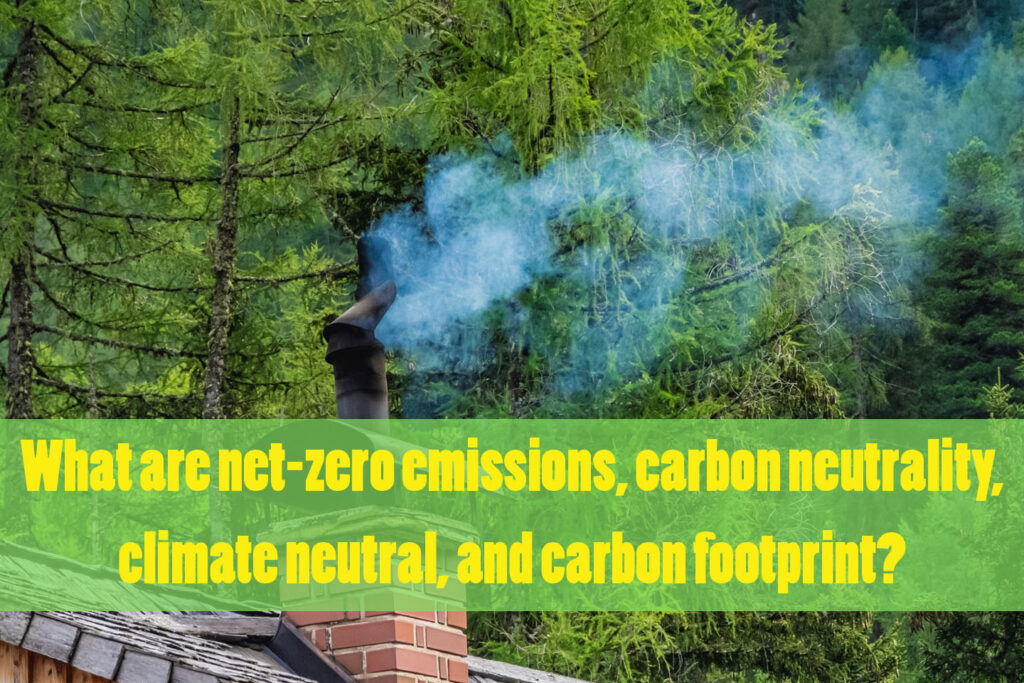
Climate warming driven by human-made greenhouse gas emissions is increasingly affecting the entire world. Nowadays, tackling climate change is at the top of the global agenda. The target set by the Intergovernmental Panel for Climate Change (IPCC) is to reach global net-zero emissions by the middle of this century and limit global warming to 2.0 or preferably 1.5 degrees Celsius.
Almost every day, we can read fresh news information, professional opinions, scientific reports, and/or environmental policy that are related to climate change. It has become popular to note such terms as “net-zero emission”, “carbon neutrality”, “carbon footprint”, and “climate neutrality” on internet or social media. What exactly do these terms mean? What is the difference between them?
Most environmental professionals are quite familiar with these terms. However, some of these terms seem not to be so easily understandable for some environment enthusiasts, young students, policy makers, business consumers, and the public. Although each of these terms has been addressed respectively in many online articles, the information is quite fragmented. The present post aims to address the diversity of these terms as clearly and concisely as possible.
- Greenhous gas emissions
Greenhouse gases are those that absorb and emit radiant energy within the thermal infrared range. The primary greenhouse gases in the atmosphere include water vapor (H2O), carbon dioxide (CO2), methane (CH4), nitrous oxide (N2O), ozone (O3), sulfur hexafluoride (SF6), hydrofluorocarbons (HFCs), and perfluorocarbons (PFCs), in addition to. Greenhouse gases, mainly CO2 and CH4, play an important role in keeping the average temperature of Earth’s surface at 15 °C (59 °F).
Since 1800, human activities have already produced a 50% increase of CO2 concentration in the atmosphere, resulting in a global warming to 1.1°C. The vast majority of greenhouse gas emissions produced by human activities come from combustion of fossil fuels including coal, oil, and natural gas. Additional contributions come from deforestation, land use, and agriculture. In recent years, global greenhouse gas emissions are about 50 Gt CO2e per year.
2. Carbon sinks
Carbon sinks refer to that carbon-containing greenhouse gases (CO2 and CH4) are absorbed or removed from the atmosphere and then accumulated or stored in objective materials (e.g., plants, trees). The two main natural carbon sink ecosystems are vegetation and phytoplankton. Therefore, carbon sinks can take place in soils, waters, forests, and oceans. According to scientific reports, global natural sinks remove between 9.5 and 11 Gt CO2 from the atmosphere every year. To date, no artificial carbon sinks can remove carbon from the atmosphere. Sometimes, the term “carbon sink” is used interchangeably with the term “carbon sequestration”.
3. Carbon offset
Carbon offset is a policy tool for different entities (governments, companies, organizations, or individuals) to mitigate or compensate for greenhouse gas emissions by purchasing a quota of reduction or removal of greenhouse gas emissions made elsewhere, in order to comply with mandatory and legally binding caps on the total amount of CO2 emissions they are allowed to emit per year or to meet carbon neutral, net-zero, or other established emission reduction goals in a short- or long-term. Carbon offsets are often measured in tonnes of carbon-dioxide-equivalence (CO2e).
4. Net-zero emissions
“Net-zero emissions” is different from “zero emission”. Zero emission means that no greenhouse gas is emitted into the atmosphere in the process of energy generation. It is usually happened when the energy is entirely produced by solar-powered, wind-powered, or water-powered technologies where no carbon-containing fuels are consumed.
Net-zero emissions refers to a balance between the amount of greenhouse gases emitted into the atmosphere, from the burning of fossil fuels and/or biomass, and the amount of greenhouse gases removed from the atmosphere via natural carbon sinks in a defined area. In other words, a state of net-zero emissions is achieved when the amount of greenhouse gases put into the atmosphere is no more than the amount taken away. This means that both the emissions and carbon sinks take place in the same place or area and that carbon emissions cannot be balanced by carbon offsetting. Net-zero emissions is usually used to describe a country or state’s commitment to decarbonization and climate action.
5. Carbon neutrality
Carbon neutrality also means that the amount of CO2 released into the atmosphere is balanced by an equivalent amount of greenhouse gases being removed. Unlike the term “net-zero emissions” which is often used to describe a country’s climate policy or action, the term “carbon neutrality” can be used to describe the state of a company, service, product, or event associated with transportation, energy production, agriculture, or industry. Carbon neutrality can be achieved by balancing the amount of CO2 emissions with their removal through reducing emissions and/or carbon offsetting.
6. Climate neutral
“Climate neutral” is a term that can be interchangeably used with “carbon neutrality”. Further, climate neutral reflects the broader inclusiveness of other greenhouse gases in climate change, even if CO2 is the most abundant. Thus, the term “climate neutral” refers to reducing the total amount of all greenhouse gases to the point of zero while eliminating all other negative environmental impacts that may be caused.
To assist organizations, companies, states, and individuals to reduce their greenhouse gas emissions and achieve climate neutrality, some countries have established national Climate Neutral Certification schemes. So far, there is no international certification scheme for climate or carbon neutrality yet. In 1999, the first Climate Neutral Network was founded in Oregon, USA. In 2008, the United Nations Environment Program (UNEP) announced that it was becoming a climate neutral organization, and that it would establish a Climate Neutral Network to promote climate neutrality.
7. Carbon footprint
Carbon footprint refers to the total amount of carbon-containing greenhouse gas (carbon dioxide, methane) emissions caused by an individual, event, organization, service, or product in daily and working activities. These activities include but are not limited to the burning of fossil fuels and biomass, land clearance, production or consumption of food, manufactured goods, or other materials, construction of roads or buildings, transportation, and the use of other services. Carbon footprint is measured in terms of carbon dioxide equivalence (CO2e). Globally, the average annual carbon footprint per person was about 6.5 tonnes CO2e in 2019. The average carbon footprint for a U.S. citizen is 16 tons CO2e – one of the highest rates in the world.
Your financial contribution does not constitute a charitable donation, but will enable us to continue delivering free quality journalism.
Select product to view






Leave a Reply